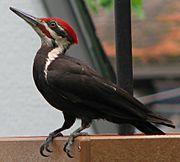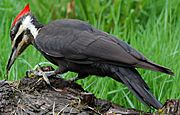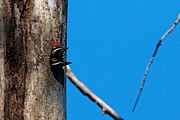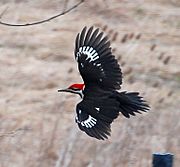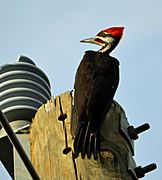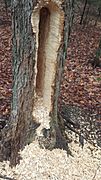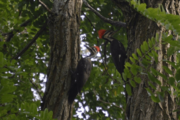Pileated woodpecker facts for kids
Quick facts for kids Pileated woodpecker |
|
|---|---|
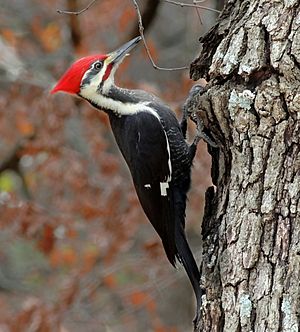 |
|
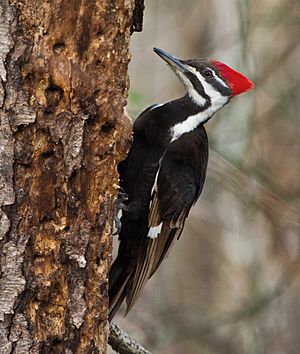 |
|
| Male (top) and female (bottom) | |
| Conservation status | |
| Scientific classification | |
| Genus: |
Dryocopus
|
| Species: |
pileatus
|
 |
|
| Range of D. pileatus | |
| Synonyms | |
|
Picus pileatus Linnaeus, 1758 |
|
The pileated woodpecker (Dryocopus pileatus) is a large, mostly black woodpecker found in North America. This bird loves to eat insects. It lives in deciduous forests in eastern North America, around the Great Lakes, in the boreal forests of Canada, and along parts of the Pacific Coast. It is the biggest common woodpecker in the U.S. The name "pileated" comes from a Latin word meaning "capped," which refers to the bird's bright red crest.
Contents
About the Pileated Woodpecker
The English naturalist Mark Catesby first described and drew the pileated woodpecker in his book The Natural History of Carolina, Florida and the Bahama Islands, published between 1729 and 1732. He called it "The larger red-crested Wood-pecker."
Later, in 1758, the Swedish naturalist Carl Linnaeus gave it the scientific name Picus pileatus. The word pileatus means "-capped" in Latin. Today, the pileated woodpecker is one of six species in the Dryocopus group, which was named by Friedrich Boie in 1826.
There are two main types, or subspecies, of pileated woodpeckers:
- D. p. abieticola – This is the northern pileated woodpecker. It lives in southern Canada and parts of the United States.
- D. p. pileatus – This is the southern pileated woodpecker. It lives in the southeastern United States.
What Does a Pileated Woodpecker Look Like?
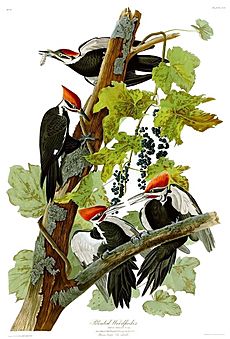
Adult pileated woodpeckers are about 40 to 49 centimeters (16 to 19 inches) long. Their wings can spread out 66 to 75 cm (26 to 30 in) wide. They usually weigh between 250 to 400 grams (8.8 to 14.1 ounces).
These woodpeckers are mostly black with a bright red crest on their heads. They also have a white stripe running down the sides of their throats. When they fly, you can see white patches on their wings. Their flight is strong and direct, but it goes up and down, which is typical for woodpeckers.
Male pileated woodpeckers have a red stripe from their beak to their throat. Females have a black stripe in the same spot. There are similar large woodpeckers in other parts of the world, like the white-bellied and black woodpeckers, that live in similar ways.
Where Do Pileated Woodpeckers Live?
Pileated woodpeckers live in forested areas across Canada, the eastern United States, and parts of the Pacific Coast. They especially like older forests and big parks with lots of trees. They prefer places with large, mature hardwood trees.
However, they can also live in smaller wooded areas if there are some tall trees around. Removing invasive plants like honeysuckle can help them, as it makes it easier for them to find food on the ground. From 1966 to 2015, the number of pileated woodpeckers has grown by more than 1.5% each year in many parts of the U.S. and Canada.
Behavior and Life Cycle
Pileated woodpeckers mostly eat insects. Their favorite foods are carpenter ants and the larvae (young bugs) of wood-boring beetles. They also enjoy fruits, nuts, and berries, including berries from poison ivy.
These woodpeckers often make large, rectangular holes in trees when they are looking for insects, especially ant colonies. They can also use their long tongues to lick up ants from cracks in the wood. They are very good at moving on the sides of large trees. They might also look for food on or near the ground, especially around fallen, dead trees where many insects live. Sometimes, they even visit bird feeders, especially in winter.
Nests and Raising Young
Pileated woodpeckers usually dig their large nests inside dead trees. The holes they make can be so big that they might even cause a small tree to break in half! A woodpecker's roost (where it sleeps) often has several entrance holes.
In April, the male woodpecker makes a hole to attract a female for mating and raising their young. Once the baby birds have grown up and left the nest, the parents abandon the hole. They do not use the same hole again the next year.
These abandoned holes are very important for many other forest animals. Owls and ducks that nest in trees often use holes made by pileated woodpeckers to lay their eggs. Even mammals like raccoons might use them. Other woodpeckers and smaller birds might visit these holes to eat the insects found inside. This shows how important woodpeckers are for the health of the forest and other bird species. Pileated woodpeckers can also nest in special boxes placed about 4.6 meters (15 feet) off the ground.
Territory and Communication
A pair of pileated woodpeckers stays together in their territory all year long. They do not migrate. They defend their territory in all seasons, but they allow other woodpeckers to be there during the winter. When they argue with other pileated woodpeckers, they chase each other, make loud calls, hit with their wings, and jab with their beaks.
They also "drum" on hollow trees to make loud sounds. This drumming is mostly to tell other birds that this territory is theirs. A drumming display is a quick burst of 11 to 30 taps in less than a second.
Pileated woodpeckers have a unique habit: if any eggs fall out of their nest, they might move to a completely new nesting site. The nest cavity is not lined with anything, just wood chips. Both parents take turns sitting on three to five eggs for 12 to 16 days. On average, they lay four eggs per nest. The young birds take about a month to learn to fly. The oldest known pileated woodpecker lived for 12 years and 11 months.
Animals that might try to eat eggs or young birds in the nest include American martens, weasels, squirrels, rat snakes, and gray foxes. Adult woodpeckers have fewer predators, but they can be caught by birds of prey like Cooper's hawks, northern goshawks, red-shouldered hawks, red-tailed hawks, great horned owls, bald eagles, golden eagles, and barred owls.
Conservation Status
The pileated woodpecker lives in a very large area and can adapt to many different places. Because it can live in various types of wooded habitats, it has survived human settlement in North America much better than the ivory-billed woodpecker, which needs very specific conditions.
Pileated woodpeckers have a large population. Even though they don't migrate, they are protected under the U.S. Migratory Bird Act. These large birds help control many insect populations, especially tree beetles. However, some people might see them as harmful if they damage trees or homes on their property while looking for bugs.
Gallery
-
Adult female at an ant-infested log
See also
 In Spanish: Picamaderos norteamericano para niños
In Spanish: Picamaderos norteamericano para niños




